Spring5
文章目录
六.bean的自动装配
是Spring满足bean依赖的一种方式
Spring会在上下文中自动寻找,并自动给bean装配属性
在Spring中有三种装配的方式
- 在xml中显示的配置
- 在java中显示配置
- 隐式的自动装配bean[重要]
1.环境搭建
一个人有两个动物
public class Dog {
public void shout(){
System.out.println("wang~");
}
}
public class Cat {
public void shout(){
System.out.println("miao~");
}
}
public class People {
private Cat cat;
private Dog dog;
private String name;
public Cat getCat() {
return cat;
}
public void setCat(Cat cat) {
this.cat = cat;
}
public Dog getDog() {
return dog;
}
public void setDog(Dog dog) {
this.dog = dog;
}
public String getName() {
return name;
}
public void setName(String name) {
this.name = name;
}
@Override
public String toString() {
return "People{" +
"cat=" + cat +
", dog=" + dog +
", name='" + name + '\'' +
'}';
}
}
<?xml version="1.0" encoding="UTF-8"?>
<beans xmlns="http://www.springframework.org/schema/beans"
xmlns:xsi="http://www.w3.org/2001/XMLSchema-instance"
xsi:schemaLocation="http://www.springframework.org/schema/beans
https://www.springframework.org/schema/beans/spring-beans.xsd">
<bean id="cat" class="com.mnm.pojo.Cat"/>
<bean id="dog" class="com.mnm.pojo.Dog"/>
<bean id="people" class="com.mnm.pojo.People">
<property name="name" value="莫诺蒙"/>
<property name="cat" ref="cat"/>
<property name="dog" ref="dog"/>
</bean>
</beans>
import com.mnm.pojo.People;
import org.junit.Test;
import org.springframework.context.ApplicationContext;
import org.springframework.context.support.ClassPathXmlApplicationContext;
public class MyTest {
@Test
public void test1(){
ApplicationContext context = new ClassPathXmlApplicationContext("beans.xml");
People people = context.getBean("people", People.class);
people.getCat().shout();
people.getDog().shout();
}
}
---------------结果---------------
miao~
wang~
2.ByName自动装配

修改beans.xml
<?xml version="1.0" encoding="UTF-8"?>
<beans xmlns="http://www.springframework.org/schema/beans"
xmlns:xsi="http://www.w3.org/2001/XMLSchema-instance"
xsi:schemaLocation="http://www.springframework.org/schema/beans
https://www.springframework.org/schema/beans/spring-beans.xsd">
<bean id="cat" class="com.mnm.pojo.Cat"/>
<bean id="dog" class="com.mnm.pojo.Dog"/>
<!--会自动在容器上下文中查找,和自己对象set方法后面的值对应的beanid 注意:区分大小写-->
<bean id="people" class="com.mnm.pojo.People" autowire="byName">
<property name="name" value="莫诺蒙"/>
</bean>
</beans>
测试
import com.mnm.pojo.People;
import org.junit.Test;
import org.springframework.context.ApplicationContext;
import org.springframework.context.support.ClassPathXmlApplicationContext;
public class MyTest {
@Test
public void test1(){
ApplicationContext context = new ClassPathXmlApplicationContext("beans.xml");
People people = context.getBean("people", People.class);
people.getCat().shout();
people.getDog().shout();
}
}
---------------结果---------------
miao~
wang~
3.ByType自动装配
<?xml version="1.0" encoding="UTF-8"?>
<beans xmlns="http://www.springframework.org/schema/beans"
xmlns:xsi="http://www.w3.org/2001/XMLSchema-instance"
xsi:schemaLocation="http://www.springframework.org/schema/beans
https://www.springframework.org/schema/beans/spring-beans.xsd">
<bean id="Cat" class="com.mnm.pojo.Cat"/>
<bean id="Dog" class="com.mnm.pojo.Dog"/>
<!--会自动在容器上下文中查找,和自己对象属性类型相同的bean方,必须保证这个类型全局唯一-->
<bean id="people" class="com.mnm.pojo.People" autowire="byType">
<property name="name" value="莫诺蒙"/>
</bean>
</beans>
测试
import com.mnm.pojo.People;
import org.junit.Test;
import org.springframework.context.ApplicationContext;
import org.springframework.context.support.ClassPathXmlApplicationContext;
public class MyTest {
@Test
public void test1(){
ApplicationContext context = new ClassPathXmlApplicationContext("beans.xml");
People people = context.getBean("people", People.class);
people.getCat().shout();
people.getDog().shout();
}
}
---------------结果---------------
miao~
wang~
小结:
- ByName我们需要保证所有bean的id唯一,而且这个bean需要和自动注入的属性的set方法的值一致!
- ByType的时候,需要保证所有bean的Class唯一,并且这个bean需要和自动注入的属性的类型一致!
4.使用注解实现自动装配
JDK1.5支持的注解,Spring从2.5开始支持注解
官网的话:
The introduction of annotation-based configuration raised the question of whether this approach is “better” than XML.
要使用注解须知:
- 导入约束,context约束
- 配置注解的支持:
<context:annotation-config/>
<?xml version="1.0" encoding="UTF-8"?>
<beans xmlns="http://www.springframework.org/schema/beans"
xmlns:xsi="http://www.w3.org/2001/XMLSchema-instance"
xmlns:context="http://www.springframework.org/schema/context"
xmlns:aop="http://www.springframework.org/schema/aop"
xsi:schemaLocation="http://www.springframework.org/schema/beans
https://www.springframework.org/schema/beans/spring-beans.xsd
http://www.springframework.org/schema/context
https://www.springframework.org/schema/context/spring-context.xsd
http://www.springframework.org/schema/aop
https://www.springframework.org/schema/aop/spring-aop.xsd">
<!--开启注解支持-->
<context:annotation-config/>
<bean id="cat" class="com.mnm.pojo.Cat"/>
<bean id="dog" class="com.mnm.pojo.Dog"/>
<bean id="people" class="com.mnm.pojo.People"/>
</beans>
import org.springframework.beans.factory.annotation.Autowired;
public class People {
@Autowired
private Cat cat;
@Autowired
private Dog dog;
private String name;
public Cat getCat() {
return cat;
}
public void setCat(Cat cat) {
this.cat = cat;
}
public Dog getDog() {
return dog;
}
public void setDog(Dog dog) {
this.dog = dog;
}
public String getName() {
return name;
}
public void setName(String name) {
this.name = name;
}
@Override
public String toString() {
return "People{" +
"cat=" + cat +
", dog=" + dog +
", name='" + name + '\'' +
'}';
}
}
测试:
import com.mnm.pojo.People;
import org.junit.Test;
import org.springframework.context.ApplicationContext;
import org.springframework.context.support.ClassPathXmlApplicationContext;
public class MyTest {
@Test
public void test1(){
ApplicationContext context = new ClassPathXmlApplicationContext("beans.xml");
People people = context.getBean("people", People.class);
people.getCat().shout();
people.getDog().shout();
}
}
---------------结果---------------
miao~
wang~
也可以写在set方法上
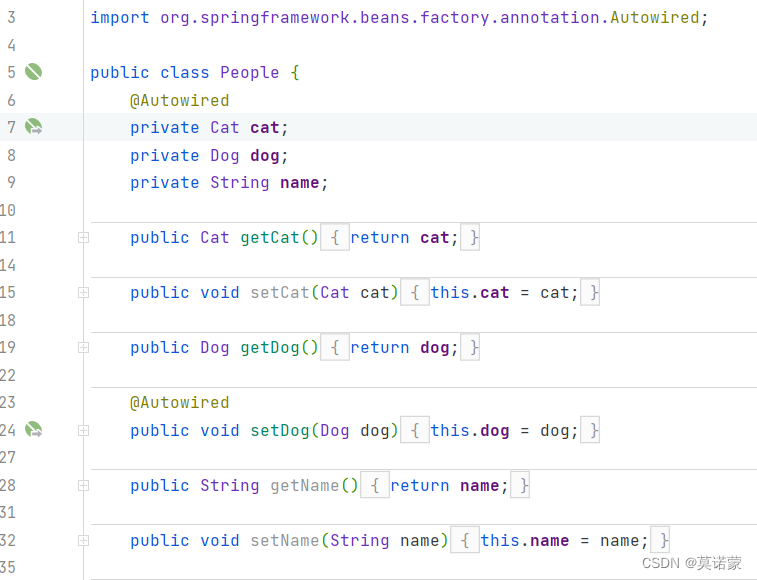
甚至可以在有注解的条件下将set方法去除掉,前提是你这个自动装配的属性在IOC(spring)容器中存在,默认按类型ByType 如果有重复值则按ByName 否则报错

科普:
@nullable 字段标记了这个注解,说明这个字段可以为null
@Autowired(required = false) 如果显示定义了Autowired的required属性为false,说明这个对象可以为null,否则不允许为空
@Qualifier(value=***) 去配合@Autowired的使用,指定一个唯一的bean对象注入 相当于将@Autowired的配置改成ByName
import org.springframework.beans.factory.annotation.Autowired;
import org.springframework.beans.factory.annotation.Qualifier;
import org.springframework.lang.Nullable;
public class People {
/*如果显示定义了Autowired的required属性为false,说明这个对象可以为null,否则不允许为空*/
@Autowired(required = false)
/*如果自动装配的环境比较复杂,自动装配无法通过一个注解[@Autowired]完成的时候,我们可以使用
* @Qualifier(value=***) 去配合@Autowired的使用,指定一个唯一的bean对象注入*/
@Qualifier(value = "cat2")
private Cat cat;
@Autowired
private Dog dog;
private String name;
public void setName(@Nullable String name) {
this.name = name;
}
public Cat getCat() {
return cat;
}
public Dog getDog() {
return dog;
}
public String getName() {
return name;
}
@Override
public String toString() {
return "People{" +
"cat=" + cat +
", dog=" + dog +
", name='" + name + '\'' +
'}';
}
}
<?xml version="1.0" encoding="UTF-8"?>
<beans xmlns="http://www.springframework.org/schema/beans"
xmlns:xsi="http://www.w3.org/2001/XMLSchema-instance"
xmlns:context="http://www.springframework.org/schema/context"
xmlns:aop="http://www.springframework.org/schema/aop"
xsi:schemaLocation="http://www.springframework.org/schema/beans
https://www.springframework.org/schema/beans/spring-beans.xsd
http://www.springframework.org/schema/context
https://www.springframework.org/schema/context/spring-context.xsd
http://www.springframework.org/schema/aop
https://www.springframework.org/schema/aop/spring-aop.xsd">
<!--开启注解支持-->
<context:annotation-config/>
<bean id="cat" class="com.mnm.pojo.Cat"/>
<bean id="cat2" class="com.mnm.pojo.Cat"/>
<bean id="dog" class="com.mnm.pojo.Dog"/>
<bean id="people" class="com.mnm.pojo.People"/>
</beans>
测试:
public class MyTest {
@Test
public void test1(){
ApplicationContext context = new ClassPathXmlApplicationContext("beans.xml");
People people = context.getBean("people", People.class);
people.getCat().shout();
people.getDog().shout();
}
}
---------------结果---------------
miao~
wang~
@Resource(name = “cat2”)
这个注解的作用和@Autowired的作用一样,只不过在jdk11后貌似被删除了
import org.springframework.beans.factory.annotation.Autowired;
import org.springframework.lang.Nullable;
import javax.annotation.Resource;
public class People {
@Resource(name = "cat2")
private Cat cat;
@Autowired
private Dog dog;
private String name;
public void setName(@Nullable String name) {
this.name = name;
}
public Cat getCat() {
return cat;
}
public Dog getDog() {
return dog;
}
public String getName() {
return name;
}
@Override
public String toString() {
return "People{" +
"cat=" + cat +
", dog=" + dog +
", name='" + name + '\'' +
'}';
}
}
<?xml version="1.0" encoding="UTF-8"?>
<beans xmlns="http://www.springframework.org/schema/beans"
xmlns:xsi="http://www.w3.org/2001/XMLSchema-instance"
xmlns:context="http://www.springframework.org/schema/context"
xmlns:aop="http://www.springframework.org/schema/aop"
xsi:schemaLocation="http://www.springframework.org/schema/beans
https://www.springframework.org/schema/beans/spring-beans.xsd
http://www.springframework.org/schema/context
https://www.springframework.org/schema/context/spring-context.xsd
http://www.springframework.org/schema/aop
https://www.springframework.org/schema/aop/spring-aop.xsd">
<!--开启注解支持-->
<context:annotation-config/>
<bean id="cat1" class="com.mnm.pojo.Cat"/>
<bean id="cat2" class="com.mnm.pojo.Cat"/>
<bean id="dog" class="com.mnm.pojo.Dog"/>
<bean id="people" class="com.mnm.pojo.People"/>
</beans>
测试:
import com.mnm.pojo.People;
import org.junit.Test;
import org.springframework.context.ApplicationContext;
import org.springframework.context.support.ClassPathXmlApplicationContext;
public class MyTest {
@Test
public void test1(){
ApplicationContext context = new ClassPathXmlApplicationContext("beans.xml");
People people = context.getBean("people", People.class);
people.getCat().shout();
people.getDog().shout();
}
}
---------------结果---------------
miao~
wang~
小结:
@Resource 和 @Autowired的区别
- 都是用来自动装配的,都可以放在属性字段上
- @Autowired 默认通过ByType的方式实现,有多个则ByName
- @Resource 默认通过ByName的方式实现,找不到则ByType
七.使用注解开发
在Spring4之后,要使用注解开发,必须要保证aop的包导入了
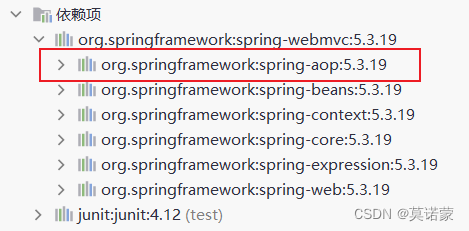
使用注解需要导入context约束,增加注解的支持,和扫描的路径
<?xml version="1.0" encoding="UTF-8"?>
<beans xmlns="http://www.springframework.org/schema/beans"
xmlns:xsi="http://www.w3.org/2001/XMLSchema-instance"
xmlns:context="http://www.springframework.org/schema/context"
xsi:schemaLocation="http://www.springframework.org/schema/beans
https://www.springframework.org/schema/beans/spring-beans.xsd
http://www.springframework.org/schema/context
https://www.springframework.org/schema/context/spring-context.xsd">
<context:component-scan base-package="com.mnm"/>
<context:annotation-config/>
</beans>
1.bean
@component:组件,放在类上,说明这个类被Spring管理了.
等价于<bean id=“user” class=“com.mnm.pojo.User”/>
import org.springframework.stereotype.Component;
/*等价于<bean id="user" class="com.mnm.pojo.User"/>
* @Component 组件*/
@Component
public class User {
public String name = "莫诺蒙";
}
2.属性如何注入
@Value(“xxx”):赋值,等价于:<property name=“name” value=“莫诺蒙”/>
import org.springframework.beans.factory.annotation.Value;
import org.springframework.stereotype.Component;
@Component
public class User {
/*等价于:<property name="name" value="莫诺蒙"/>*/
@Value("莫诺蒙")
public String name;
}
或者
import org.springframework.beans.factory.annotation.Value;
import org.springframework.stereotype.Component;
@Component
public class User {
public String name;
@Value("莫诺蒙")
public void setName(String name) {
this.name = name;
}
}
3.衍生的注解
@Component有几个衍生注解,我们在web开发中,会按照mvc三层架构分层
dao[@Repository]
service[@Service]
controller[@Controller]
这四个注解功能都是一样的,都代表将某个类注册到Spring容器中,装配bean
import org.springframework.stereotype.Repository;
@Repository
public class UserDao {
}
import org.springframework.stereotype.Service;
@Service
public class UserService {
}
import org.springframework.stereotype.Controller;
@Controller
public class UserController {
}
4.自动装配
上面有详细讲过
@AutoWired:自动装配通过类型,名字
@Qualifier(value=“xxx”):指定一个唯一的bean对象注入 相当于将@Autowired的配置改成ByName
@Resource:自动装配通过名字,类型
5.作用域
import org.springframework.beans.factory.annotation.Value;
import org.springframework.context.annotation.Scope;
import org.springframework.stereotype.Component;
@Component
/*标注单例模式:singleton 原型:prototype */
@Scope("singleton")
public class User {
@Value("莫诺蒙")
public String name;
}
6.小结
XML与注解
- XML更加万能,适用于任何场合,维护简单方便
- 注解不是自己的类使用不了,维护相对复杂
XML与注解最佳实践:
- XML用来管理bean
- 注解只负责完成属性的注入
- 我们在使用的过程中,只需要注意一个问题,必须让注解生效,就需要开启注解的支持
八.使用java的方式配置Spring
我们现在要完全不适用Spring的xml配置,全权交给Java来做
JavaConfig是Spring的一个子项目,在Spring4之后,它成为了一个核心功能
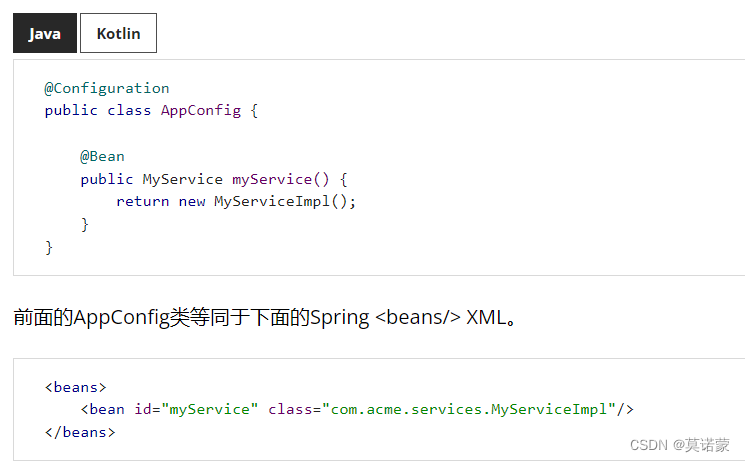
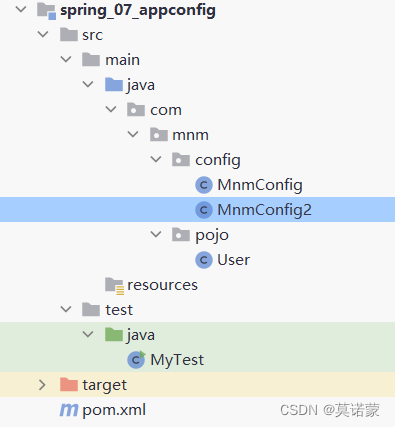
实体类
import org.springframework.beans.factory.annotation.Value;
import org.springframework.stereotype.Component;
@Component
public class User {
private String name;
public String getName() {
return name;
}
/*注入初始值*/
@Value("莫诺蒙")
public void setName(String name) {
this.name = name;
}
@Override
public String toString() {
return "User{" +
"name='" + name + '\'' +
'}';
}
}
配置类
import com.mnm.pojo.User;
import org.springframework.context.annotation.Bean;
import org.springframework.context.annotation.ComponentScan;
import org.springframework.context.annotation.Configuration;
import org.springframework.context.annotation.Import;
/*这个也会被Spring托管,注册到容器中,因为他本来就是一个@Component
* @Configuration代表这是一个配置类,就和我们之前看的beans.xml
* */
@Configuration
/*配套@Component使用*/
@ComponentScan("com.mnm.pojo")
@Import(MnmConfig2.class)
/*注意:就是说,@Bean是相当于<bean>标签创建的对象,而我们之前学的@Component是通过spring自动创建的这个被注解声明的对象
* 所以这里去掉@Bean这些东西,然后开启扫描。之后在User头上用@Component即可达到spring自动创建User对象了
* 所以这里相当于有两个User对象被创建了。一个是bean标签创建的(@Bean),一个是通过扫描然后使用@Component,spring自动创建的User对象
* 这里还可以使用@ImportResource(String [ ] )注解来引入其他xml配置文件
* */
public class MnmConfig {
/*注册一个bean,就相当于我们之前写的一个bean标签,
这个方法的名字,就相当于bean标签中的id,
这个方法的返回值,就相当于bean标签中的class属性*/
@Bean
public User myUser(){
return new User();
}
}
import com.mnm.config.MnmConfig;
import com.mnm.pojo.User;
import org.springframework.context.ApplicationContext;
import org.springframework.context.annotation.AnnotationConfigApplicationContext;
public class MyTest {
public static void main(String[] args) {
//如果完全使用了配置类方式去做,我们就只能通过AnnotationConfig 上下文来获取容器,通过配置类的class对象加载
ApplicationContext Context = new AnnotationConfigApplicationContext(MnmConfig.class);
User getUser = Context.getBean("myUser", User.class);
System.out.println(getUser.getName());
}
}
---------------结果---------------
莫诺蒙
去掉@bean后
扫描创建的User对象,名称为首字母小写的user,测试类中要稍作修改
import com.mnm.config.MnmConfig;
import com.mnm.pojo.User;
import org.springframework.context.ApplicationContext;
import org.springframework.context.annotation.AnnotationConfigApplicationContext;
public class MyTest {
public static void main(String[] args) {
//如果完全使用了配置类方式去做,我们就只能通过AnnotationConfig 上下文来获取容器,通过配置类的class对象加载
ApplicationContext Context = new AnnotationConfigApplicationContext(MnmConfig.class);
User getUser = Context.getBean("user", User.class);
System.out.println(getUser.getName());
}
}
这种纯java的配置ifangshi,在SpringBoot中随处可见
九.代理模式
为什么要学习代理模式:
因为这就是SpringAOP的底层!
面试重点:[SpringAOP和SpringMVC]
代理模式的分类:
- 静态代理
- 动态代理
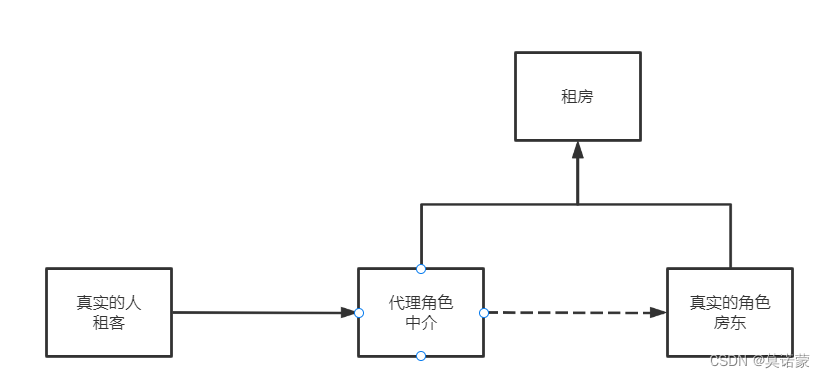
1.静态代理
角色分析:
- 抽象的角色:一般会使用接口或者抽象类来解决
- 真实角色:被代理的角色
- 代理角色:代理真实角色,代理真实角色后,我们一般会做一些附属操作
- 客户:访问代理对象的人
首先,我们需要建立一个java工程来实现一个例子,从而理解什么是java中的静态代理;
我们需要在项目中新建一个包,然后在包下建一个接口,租房的接口(Rent),紧接着呢,我们在接口中创建一个租房的方法:
package com.mnm.demo01;
//租房
public interface Rent {
public void rent();
}
这个方法就被称之为抽象方法,接下来呢,我将会去写一个实现类,它们分别是,房东(Landlord)实现类,紧接着,我们需要让这个类实现Rent这个接口,并实现Rent类中定义好的抽象方法:
package com.mnm.demo01;
/*房东*/
public class Landlord implements Rent{
@Override
public void rent() {
System.out.println("房东要出租房子");
}
}
但是,房东一般没有那么多时间去管理出租这个事务,所以出现了中介,中介帮你实现这些东西
首先,我们需要建一个类Proxy,中介类
刚才房东类实现了一个接口(Rent),那么它的代理类,也必须要去实现Rent,出租的方法实际上还是房东在做
既然需要在代理对象中,需要去调用房东租房的方法,那这个代理对象(Proxy)的代理类中,是不是就需要有房东的属性:
如果直接使用landlord,执行必然是空指针异常,所以,我们需要给这个房东对象使用构造器进行初始化;
package com.mnm.demo01;
/*中介*/
public class Proxy implements Rent{
private Landlord landlord;
public Proxy() {
this.landlord = new Landlord();
}
@Override
public void rent(){
seeHouse();
landlord.rent();
fee();
contract();
}
public void seeHouse(){
System.out.println("中介带你看房子");
}
public void fee(){
System.out.println("收中介费");
}
public void contract(){
System.out.println("签合同");
}
}
这个时候,我们再去租房,就只需要经过代理而不需要直面房东了
package com.mnm.demo01;
/*租客*/
public class Client {
public static void main(String[] args) {
//你不用接触房东直接租房
Proxy proxy = new Proxy();
proxy.rent();
}
}
---------------结果---------------
中介带你看房子
房东要出租房子
收中介费
签合同
代理模式的好处:
- 可以使真实角色的操作更加纯粹,不用去关注一些公共的业务
- 公共的业务就交给代理角色,实现了业务的分工
- 公共业务发生扩展的时候,方便集中管理
缺点:
- 一个真实角色就会产生一个代理角色,代码量会翻倍,开发效率变低
2.加深理解
公司现在要为原来的业务代码增加一个日志功能
修改公司原有的业务代码是大忌,这时我们新增一个代理来处理这个功能
公司原有的业务接口
package com.mnm.demo02;
/*抽象方法*/
public interface UserService {
public void add();
public void delete();
public void update();
public void query();
}
业务的实现类,也就是真实对象
package com.mnm.demo02;
/*真实对象*/
public class UserServiceImpl implements UserService{
@Override
public void add() {
System.out.println("增加了一个用户");
}
@Override
public void delete() {
System.out.println("删除了一个用户");
}
@Override
public void update() {
System.out.println("修改了一个用户");
}
@Override
public void query() {
System.out.println("查询了一个用户");
}
}
这时我们新增一个代理,在真实对象的基础上增加日志的实现
package com.mnm.demo02;
public class UserServiceProxy implements UserService{
private UserServiceImpl userService;
public UserServiceProxy() {
this.userService = new UserServiceImpl();
}
@Override
public void add() {
log("add");
userService.add();
}
@Override
public void delete() {
log("delete");
userService.delete();
}
@Override
public void update() {
log("update");
userService.update();
}
@Override
public void query() {
log("query");
userService.query();
}
//日志方法
public void log(String msg){
System.out.println("[debug]使用了"+msg+"方法");
}
}
测试:这时我们既没有修改之前的业务代码,也能实现日志输出功能
package com.mnm.demo02;
public class Client {
public static void main(String[] args) {
UserServiceProxy userServiceProxy = new UserServiceProxy();
userServiceProxy.delete();
}
}
---------------结果---------------
[debug]使用了delete方法
删除了一个用户
..
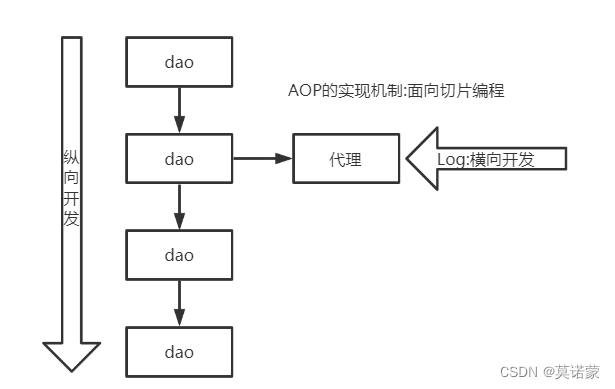
3.动态代理
动态代理和静态代理角色一样
动态代理的代理类是动态生成的,不是我们直接写好的!
动态代理也分为两大类
- 基于接口的动态代理
- 基于类的动态代理
基于接口:JDK的动态代理[我们使用的]
基于类的:cglib
java字节码实现:javassist
使用前需要了解两个类:Proxy(代理),InvocationHandler(调用处理程序)
InvocationHandler在反射包下


且只有一个方法invoke

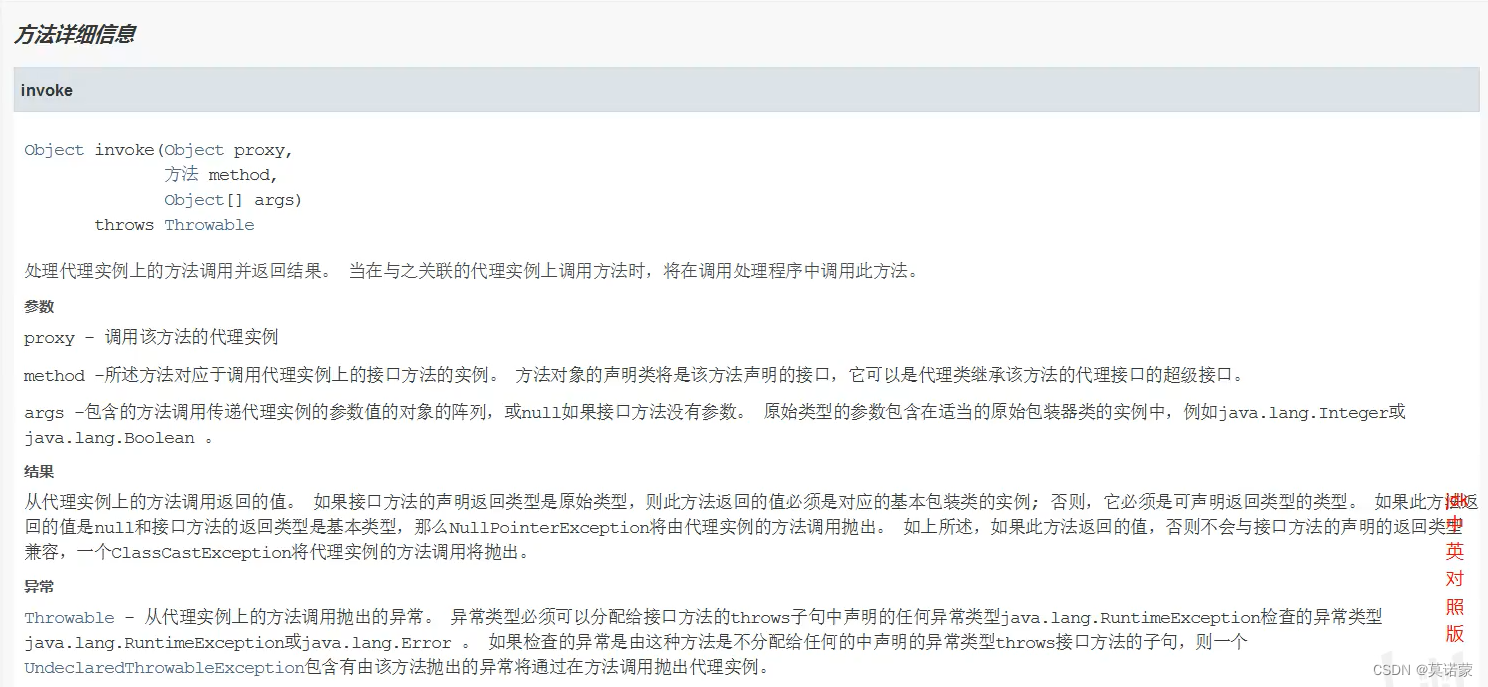
更重要的Proxy


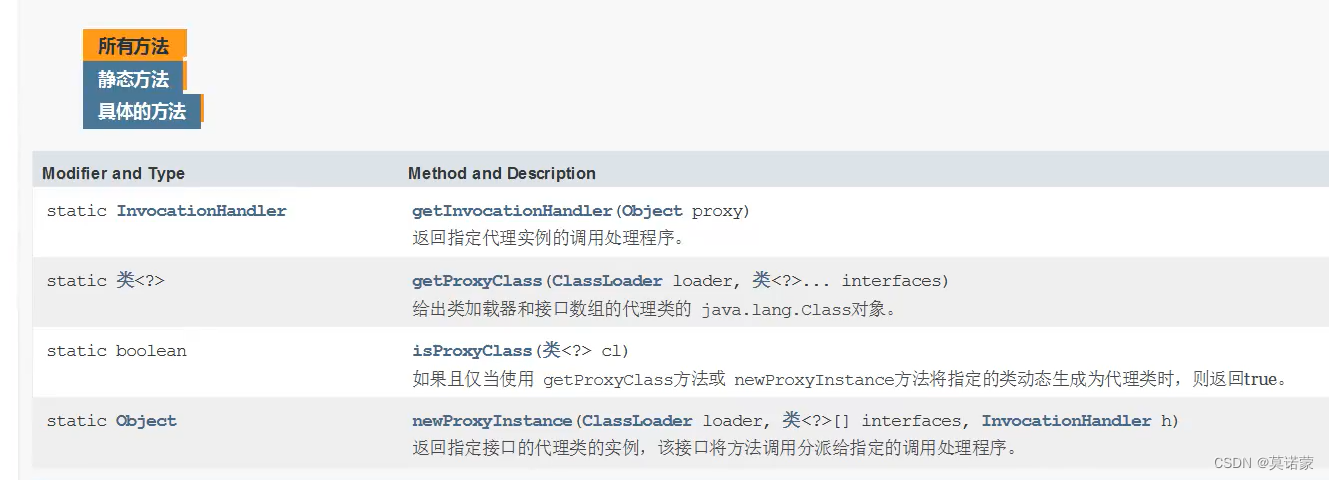
动态代理的好处:
- 可以使真实角色的操作更加纯粹,不用去关注一些公共的业务
- 公共的业务就交给代理角色,实现了业务的分工
- 公共业务发生扩展的时候,方便集中管理
- 一个动态代理类代理的是一个接口,一般就是对应的一类业务
- 一个动态代理类,可以代理多个类,只要是实现了同一个接口的即可
动态代理实例:
重写租房案例:
依然是租房接口:
package com.mnm.demo03;
public interface Rent {
public void rent();
}
和要将房子出租的房东:
package com.mnm.demo03;
public class Landlord implements Rent{
@Override
public void rent() {
System.out.println("房东要出租房子");
}
}
动态代理,通俗点说就是:无需声明式的创建java代理类,而是在运行过程中生成"虚拟"的代理类,被ClassLoader加载。从而避免了静态代理那样需要声明大量的代理类。
package com.mnm.demo03;
import java.lang.reflect.InvocationHandler;
import java.lang.reflect.Method;
import java.lang.reflect.Proxy;
/*代理处理程序
* 我们会用这个类,自动生成代理类*/
public class ProxyInvocationHandler implements InvocationHandler {
/*被代理的接口*/
private Rent rent;
public void setRent(Rent rent) {
this.rent = rent;
}
/*生成得到代理对象*/
public Object getProxy(){
return Proxy.newProxyInstance(this.getClass().getClassLoader(), rent.getClass().getInterfaces(), this);
}
/*处理代理实例,并返回结果*/
@Override
public Object invoke(Object proxy, Method method, Object[] args) throws Throwable {
/*动态代理的本质,就是使用反射机制实现*/
seeHouse();
Object result = method.invoke(rent, args);
fare();
return result;
}
public void seeHouse(){
System.out.println("中介带你看房子");
}
public void fare(){
System.out.println("收中介费");
}
}
测试类:
package com.mnm.demo03;
public class Client {
public static void main(String[] args) {
//真实角色
Landlord landlord = new Landlord();
//代理角色,现在没有
ProxyInvocationHandler pih = new ProxyInvocationHandler();
//通过调用程序处理角色来处理我们要调用的接口对象
pih.setRent(landlord);
//这里的proxy就是动态生成的,我们并没有写
Rent proxy =(Rent) pih.getProxy();
proxy.rent();
}
}
---------------结果---------------
中介带你看房子
房东要出租房子
收中介费
4.重写增删改查
不变的增删改查接口
package com.mnm.demo02;
/*抽象方法*/
public interface UserService {
public void add();
public void delete();
public void update();
public void query();
}
实现类也没有任何修改
package com.mnm.demo02;
/*真实对象*/
public class UserServiceImpl implements UserService{
@Override
public void add() {
System.out.println("增加了一个用户");
}
@Override
public void delete() {
System.out.println("删除了一个用户");
}
@Override
public void update() {
System.out.println("修改了一个用户");
}
@Override
public void query() {
System.out.println("查询了一个用户");
}
}
代理类也只需稍作修改,基本可以当做模板
package com.mnm.demo04;
import com.mnm.demo03.Rent;
import java.lang.reflect.InvocationHandler;
import java.lang.reflect.Method;
import java.lang.reflect.Proxy;
/*代理处理程序
* 我们会用这个类,自动生成代理类*/
public class ProxyInvocationHandler implements InvocationHandler {
/*被代理的接口*/
private Object target;
public void setTarget(Object target) {
this.target = target;
}
/*生成得到代理对象*/
public Object getProxy(){
return Proxy.newProxyInstance(this.getClass().getClassLoader(), target.getClass().getInterfaces(), this);
}
/*处理代理实例,并返回结果*/
@Override
public Object invoke(Object proxy, Method method, Object[] args) throws Throwable {
/*动态代理的本质,就是使用反射机制实现*/
log(method.getName());
Object result = method.invoke(target, args);
return result;
}
public void log(String msg){
System.out.println("执行了"+msg+"方法");
}
}
测试类:
package com.mnm.demo04;
import com.mnm.demo02.UserService;
import com.mnm.demo02.UserServiceImpl;
public class Client {
public static void main(String[] args) {
//真实角色
UserServiceImpl userService = new UserServiceImpl();
//代理角色,不存在
ProxyInvocationHandler pih = new ProxyInvocationHandler();
//设置要代理的对象
pih.setTarget(userService);
//动态生成代理类
UserService proxy =(UserService) pih.getProxy();
proxy.delete();
}
}
---------------结果---------------
执行了delete方法
删除了一个用户
